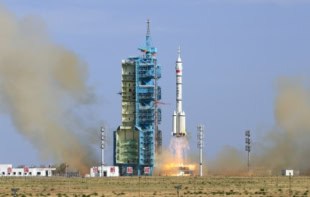
The increasing deployment of extensive space-based infrastructure is predicted to triple the number of objects in low-Earth orbit over the next century. But at the end of their service life, decommissioned satellites burn up as they re-enter the atmosphere, triggering chemical reactions that deplete the Earth’s ozone layer.
Through new simulations, Joseph Wang and colleagues at the University of Southern California have shown how nanoparticles created by satellite pollution can catalyse chemical reactions between ozone and chlorine. If the problem isn’t addressed, they predict that the level of ozone depletion could grow significantly in the coming decades.
From weather forecasting to navigation, satellites are a vital element of many of the systems we’ve come to depend on. As demand for these services continues to grow, swarms of small satellites are being rolled out in mega-constellations such as Starlink. As a result, low-Earth orbit is becoming increasingly cluttered with manmade objects.
Once a satellite reaches the end of its operational lifetime, international guidelines suggest that it should re-enter the atmosphere within 25 years to minimize the risk of collisions with other satellites. Yet according to Wang’s team, re-entries from a growing number of satellites are a concerning source of pollution; and one that has rarely been considered so far.
As they burn up on re-entry, satellites can lose between 51% and 95% of their mass – and much of the vaporized material they leave behind will remain in the upper atmosphere for decades.
One particularly concerning component of this pollution is aluminium, which makes up close to a third of the mass of a typical satellite. When left in the upper atmosphere, aluminium will react with the surrounding oxygen, creating nanoparticles of aluminium oxide (AlO). Although this compound isn’t reactive itself, its nanoparticles have large surface areas and excellent thermal stability, making them extremely effective at catalysing reactions between ozone and chlorine.
For this ozone–chlorine reaction to occur, chlorine-containing compounds must first be converted into reactive species – which can’t happen without a catalyst. Typically, catalysts come in the form of tiny, solid particles found in stratospheric clouds, which provide surfaces for the chlorine activation reaction to occur. But with higher concentrations of AlO nanoparticles in the upper atmosphere, the chlorine activation reaction can occur more readily – depleting the vital layer that protects Earth’s surface from damaging UV radiation.
Backwards progress
The ozone layer has gradually started to recover since the signing in 1987 of the Montreal Protocol – in which all UN member states agreed to phase out production of the substances primarily responsible for ozone depletion. With this new threat, however, Wang’s team predict that much of this progress could be reversed if the problem isn’t addressed soon.
In their study, reported in Geophysical Research Letters, the researchers assessed the potential impact of satellite-based pollution through molecular dynamics simulations, which allowed them to calculate the mass of ozone-depleting nanoparticles produced during satellite re-entry.
They discovered that a small 250 kg satellite can generate around 30 kg of AlO nanoparticles. By extrapolating this figure, they estimated that in 2022 alone, around 17 metric tons of AlO compounds were generated by satellites re-entering the atmosphere. They also found that the nanoparticles may take up to 30 years to drift down from the mesosphere into the stratospheric ozone layer, introducing a noticeable delay between satellite decommissioning and eventual ozone depletion in the stratosphere.

The danger of contaminating the night sky
Extrapolating their findings further, Wang’s team then considered the potential impact of future mega-constellation projects currently being planned. Altogether, they estimate that some 360 metric tons of AlO nanoparticles could enter the upper atmosphere each year if these plans come to fruition.
Although these estimates are still highly uncertain, the researchers’ discoveries clearly highlight the severity of the threat that decommissioned satellites pose for the ozone layer. If their warning is taken seriously, they hope that new strategies and international guidelines could eventually be established to minimize the impact of these ozone-depleting nanoparticles, ensuring that the ozone layer can continue to recover in the coming decades.



